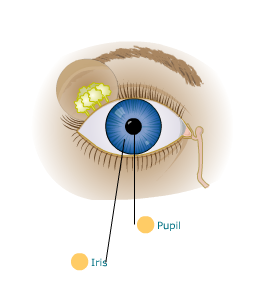The iris and pupil
The iris is a circular screen composed of:
- some pigment cells, which determine eye colour, and
- two sets of muscle fibres.
The hole in the centre of the iris is the pupil. The size of the pupil is governed by the action of the muscle fibres in the iris. One set of muscle fibres is arranged in a circular fashion, while the other extends in a radial manner like the spokes of a wheel.
In bright light, the circular muscles contract. This constricts (reduces the size of) the pupil, to limit the amount of light entering the eye and prevent the retina from being over-stimulated.
In dim light, the radial muscles contract. This dilates (enlarges) the pupil, letting more light into the eye.

